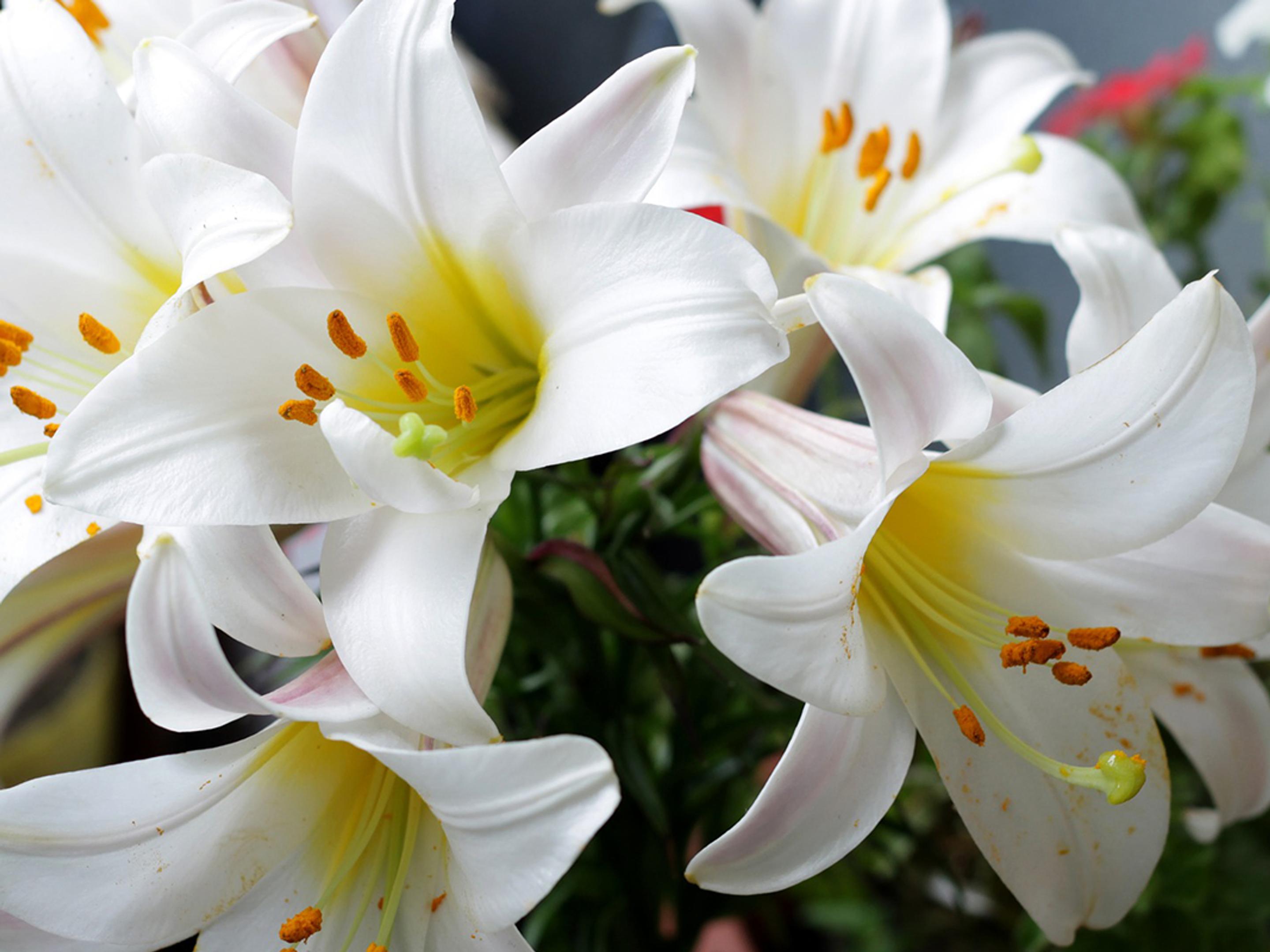
March 4, 2025
How to Care for Easter Lilies: Growing & Maintaining These Beautiful Blooms
March 4, 2025
Is there anything more lovely than the beginning of spring? The sun is in the sky, nature is waking up again, and the air is full of the smell of fresh spring flowers.
And if there’s one bloom that sums up the season for us, it’s the stunning Easter lily. This popular springtime flower is elegant and beautiful, filling any room with a sweet and delightful fragrance. As the name suggests, this flower is also particularly popular over the Easter season, thanks to its religious significance as a symbol of purity, hope, and rebirth.
But these gorgeous blooms aren’t only found in churches. Easter lilies can also be gifted as a plant or as part of a stunning Easter flower arrangement.
When given the right care and attention, Easter lilies can thrive both indoors and indoors. So, knowing how to care for Easter lilies properly is key to enjoying the scent and beauty of these lovely flowers for as long as possible!
What Are Easter Lilies? A Look at Their Beauty & Symbolism

Although scientifically known as ‘lilium longiflorum,’ this flower has come to be known as the ‘Easter lily.’ Native to the Ryukyu Islands in southern Japan, these beautiful flowers were first brought to England in 1818 and America in 1898.
So, what does an Easter lily symbolize, and what are some Easter lily meanings? Well, the significance of Easter lily flowers in religion makes them a popular choice in religious buildings like churches during the Easter season. These beautiful blooms are often seen when celebrating the resurrection of Jesus Christ, making them a traditional symbol of purity and renewal.
And these aren’t the only lilies seen in churches at Easter! Calla lilies are another white bloom which have plenty of religious significance, too.
What Do Easter Lilies Look Like?

So, what does an Easter lily look like? Tall in height and featuring large trumpet-shaped blooms that are bright white in color, the Easter lily is both striking and elegant. But this flower isn’t just popular for its appearance. Its sweet, strong scent is similar to a blossoming cherry tree and can easily fill any room with floral loveliness.
How Tall Do Easter Lilies Grow?
“How big do Easter lilies get?” we hear you ask. Well, Easter lilies are known for their long stems and tend to reach up to 3 feet tall when grown outside! As long as they have the proper sunlight and space, they will stand tall and proud in any garden. Easter lilies won’t grow quite as tall when grown inside, but they still usually reach around 2 feet.
Top tip: if you’re planting multiple Easter lilies outside, remember to leave around 12 to 18 inches between each flower so they have ample room to reach their full height.
How to Care for Easter Lilies Indoors & Outdoors
Remember these top tips to keep Easter lilies blooming and healthy: Easter lilies love plenty of bright but indirect light, so avoid keeping them in dark corners of your garden or house. It’s also important not to overwater Easter lily plants, so we recommend only watering when the top layer of soil is dry to the touch.
Looking for more tips on caring for Easter lilies indoors and outdoors? You’re in the right place.
How to Care for Easter Lilies Indoors
If you’re growing your Easter lily plant indoors, try to keep it somewhere where it can soak up bright but indirect light. Easter lilies will absolutely thrive near a window with a sheer curtain!
Easter lilies also love to be kept in cool temperatures of around 65 to 70°F, so avoid keeping them near any radiators.
How to Care for Easter Lilies Outdoors
Wondering how to plant Easter lilies? After Easter lilies have finished blooming indoors, you can easily move them outside. Just make sure you wait until the flowers have faded before deadheading them, then wait for the foliage to die off. Once this has happened, you can remove the bulb from its pot and replant it outside in your garden. It’s really easy with the right care and attention!
Outdoor Easter lilies will rebloom each year. Just make sure to deadhead flowers once they’ve finished blooming. You also cut back the stems, though not until they turn brown and wither! This will help the Easter lilies to keep hold of energy for next year’s blooming season.
How Often to Water Easter Lilies?
While Easter lilies love regular watering, it’s important not to overwater. You’ll want to keep the top layer of soil moist, so if it’s dry to the touch, then your Easter lily probably needs a bit more H2O!
If your Easter lily has been overwatered, you might notice yellow leaves and potential root rot, while an Easter lily that’s been underwatered may have dry or dropping leaves. If you notice any of these signs, make sure to adjust your watering schedule accordingly.
How to Keep Easter Lilies Blooming Longer
We’ll let you in on a secret: there’s a really simple way to keep Easter Lilies blooming longer.
Sure, you should follow all the guidance above (keep them in bright, indirect light and cool temperatures, and only water them when the top layer of soil is dry), but the real trick to keeping Easter lilies fresh is to remove the yellow anthers from the center of each flower as they open.
You can also prune back browning or yellowing leaves, and deadhead dyeing petals to help the flower conserve energy and keep blooming.
If you’re keeping your Easter lilies outside, make sure you fertilize them in early spring so they bloom for longer, and then feed the soil again after flowering to prepare the bulbs for next year’s blooming season.
How to Grow Easter Lilies for Year-Round Beauty

Growing Easter lilies outside isn’t as hard as you might think. Just pick a spot with good drainage and up to 6 hours of sun light. The bulbs should be planted either in autumn or after the last frost of winter and placed 6 to 8 inches below the surface. Make sure you water and fertilize them well in spring, so they’re ready to bloom.
In the warmer months, your Easter lilies will grow tall, so be ready to add stakes to support the long stems. Don’t forget to follow our tips on helping them bloom for longer. Oh and remember to admire their beauty too! As the flowers fade in autumn, wait for the foliage to die off then cut the stems all the way to ground level. Don’t panic! They’ll grow back just as tall and beautiful next year.
Over winter, Easter lilies require little care. If you live in mild climates, you don’t need to do anything. If it gets frosty, it’s best to apply a thick layer of mulch to protect them from deep freezes. Then, come spring, remove the mulch and the cycle repeats itself!
Are Easter Lilies Poisonous to Cats & Dogs?

If you’re a cat parent, beware! Easter lilies are highly toxic to our feline friends. It’s definitely worth steering clear of these blooms if you have cats around.
Are Easter lilies poisonous to dogs, too, then? Well, if you’re more of a canine person, it’s probably still worth avoiding Easter lilies. While they’re not highly toxic to dogs, your pup could still experience vomiting or diarrhea if they get their paws on this plant.
Celebrate with Easter Lilies: The Perfect Holiday Gift
Easter lilies are beautiful and fragrant, and make the perfect meaningful gift over the Easter season. So whether you choose to gift an Easter lily plant, an Easter bouquet, or other lily arrangements, you can bet you’ll make the recipient feel totally loved and appreciated.
Want to learn more about other popular Easter flowers? Explore our top ten favorite Easter blooms.
Enjoying the Beauty of Easter Lilies
Easter lilies are beautiful and symbolic springtime flowers that can thrive both indoors and outdoors with the proper care and attention. With the right amount of sunlight, water, and cool temperatures, your Easter lilies will stay looking and smelling amazing all season long.
Ready for Easter? Shop our full range of Easter flowers today.


